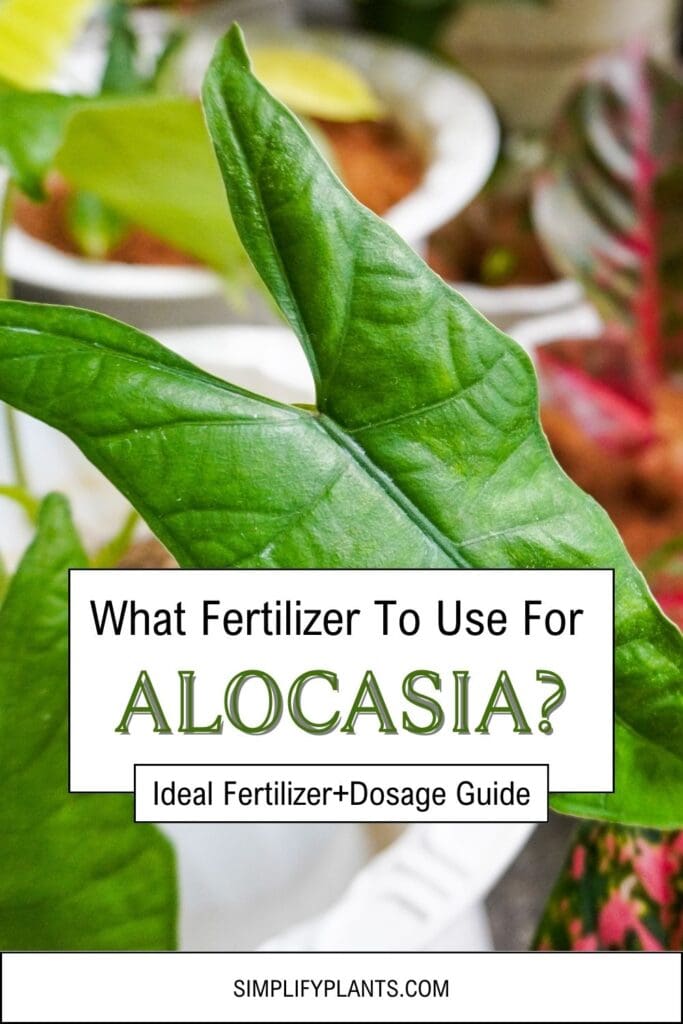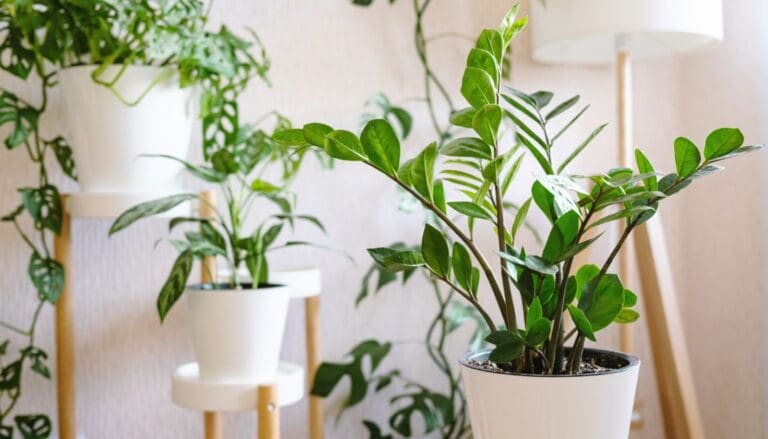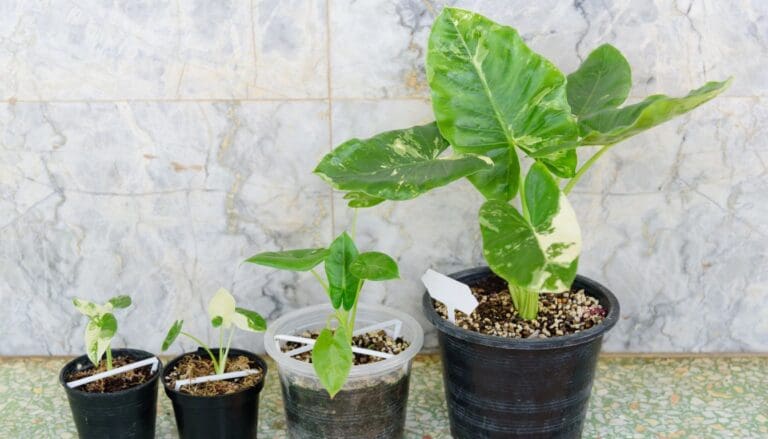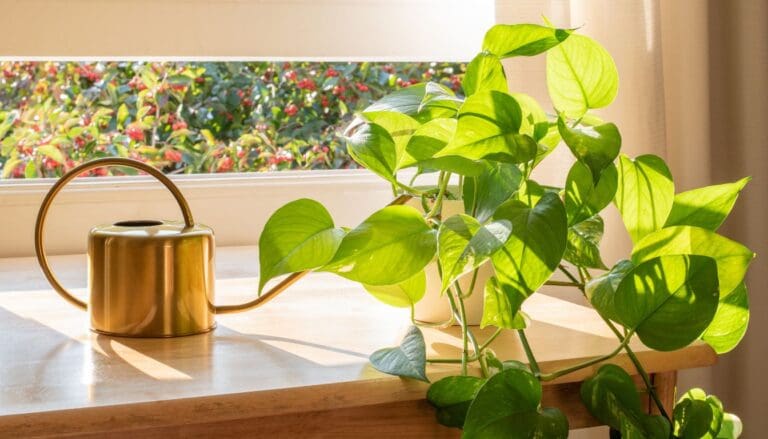Fertilizer For Alocasia? (Ideal Fertilizer+Dosage Guide)
Have you ever wondered about the best fertilizer for your Alocasia plant and how much to use?
In this blog, we will talk about the ideal fertilizer for Alocasia plants and provide a guide on how much or how often to use it.
In general, Alocasia prefers a balanced liquid fertilizer with an NPK ratio of 20:20:20. Alocasia is a heavy feeder; therefore, you need to fertilize it throughout its growing season. Adding organic matter, seaweed extracts, or compost can help with the plant’s nutrient needs.
In this article, we will discuss the best fertilizer for Alocasia, how to fertilize it, and when is the best time to fertilize it. So, keep reading.

Please note: Simplify Plants is reader-supported. Some links in the post are affiliate links and I get a commission from purchases made through links in the post.
Does Alocasia need fertilizer?
Alocasia is a fast-growing tropical plant that requires a continuous supply of nutrients for growth.
When preparing a soil mix for your Alocasia, you should consider that the plant should get enough nutrients from the soil.
Therefore, preparing nutrient-rich soil becomes important.
But the soil loses the nutrients over time as the plant absorbs some, while some are washed away with each watering.
This is where fertilizer comes to help.
Applying regular fertilizer to the Alocasia will help it get enough nutrients.
Without proper fertilization, the Alocasia will experience various problems such as:
- Stunted growth
- Smaller leaves
- Droopy leaves
- Pale foliage
- Weak stems
- Leggy growth
- Weak roots
If you don’t fertilize your Alocasia, it will weaken over time and cease to thrive.
If you notice any of the above signs in your Alocasia, you must re-evaluate your fertilizing schedule, and if you don’t fertilize the plant, you should start it.
What nutrients do fertilizers have?

Many fertilizers are available in the market, but to understand which is best for your Alocasia, you must understand what nutrients fertilizers provide.
Houseplants mainly require two types of nutrients:
- Micronutrients
- Macronutrients
Now, let’s understand the components of the nutrients and how these help Alocasia.
Macronutrients: Macronutrients are the most important nutrients the plant needs for growth.
Alocasia will require macronutrients in a considerable amount.
These are the NPK we mentioned while discussing the ideal fertilizer for the plants.
NPK stands for Nitrogen, Phosphorus, and Potassium.
| Nutrients | Function |
|---|---|
| Nitrogen | Promotes root growth Encourages photosynthesis Promotes foliage growth |
| Phosphorus | Promotes root development Helps in regulating water around the plant |
| Potassium | Increases the immunity of the plant It makes the plant resilient Encourages nutrient flow to all parts |
Plants also need some other nutrients besides NPK.
Some of these are:
- Calcium
- Magnesium
- Sulfur
- Hydrogen
- Oxygen
- Carbon
Micronutrients: As the name suggests, Plants need minimal amounts of these nutrients.
These nutrients are:
- Iron
- Copper
- Zinc
- Boron
- Manganese
What is the best fertilizer for Alocasia?
Different plants have different NPK ratio requirements.
Alocasia plants will do well with a well-balanced fertilizer with an NPK ratio of 20:20:20.
Since the nutrients are balanced in such fertilizers, your Alocasia will receive an even distribution of all the macronutrients.
You can opt for the commercial fertilizers prepared specifically for Alocasia plants.
Otherwise, it is best to use a liquid fertilizer with 20:20:20 NPK.
When applying the fertilizer, you must dilute it to reduce the strength to avoid any chance of overfertilization.
You can also give the plant slow-release fertilizer with an NPK of 20:10:20.
However, this is more suitable for an outdoor plant.
Types of fertilizers
There are 3 types of fertilizers:
- Slow-release fertilizer
- Granular fertilizer
- Liquid fertilizer
Slow-release fertilizer
Slow-release fertilizers release the nutrients slowly.
Slow-release fertilizers are best suited for outdoor plants.
So, if you are growing your Alocasia outdoors, you can use a slow-release fertilizer to fertilize it.
These fertilizers will release nutrients every time you water the plant.
The only problem with this fertilizer is that you can’t control the amount of nutrients that the plant gets.
Granular fertilizer
Granular fertilizers are available in a pellet form.
You need to add these to the soil directly.
This type of fertilizer is suitable for outdoor plants as these fertilizers contain a lot of Nitrogen and Potassium, which are not suitable for indoor plants.
I will not recommend this type of fertilizer for the Alocasia plant as this species requires nutrients in a balanced ratio.
Using granular fertilizers can overfertilize your Alocasia and burn the roots.
Liquid fertilizer

Liquid fertilizer is the ideal type of fertilizer for both indoor and outdoor Alocasia.
Liquid fertilizers are available in 2 forms:
- Liquid
- Powder
You need to mix the powder with water to get a liquid fertilizer.
You can get the exact ratio of nutrients suitable for your specific plant in liquid fertilizers and even dilute it to avoid overfertilization.
Suggested fertilizer for Alocasia
Since different fertilizers are available in the market, you might get confused about which one you should get for your Alocasia.
Don’t worry; I have suggested some fertilizers best suited for your Alocasia and will help the plant grow faster.
- Jacks Classic 20-20-20 All-Purpose Fertilizer
- Charlie’s Compost
- All-purpose houseplant fertilizer
If you are confused, get any of these fertilizers for your Alocasia.
Organic fertilizers for Alocasia
Many enthusiasts don’t like using commercial fertilizers for their plants.
If you are one of them, I have some organic suggestions too.
Compost tea
To make compost tea, you must put a significant amount of compost in a gunny sack and leave it in water for 3 weeks.
After that, you will notice that the water will turn yellow or brownish, and then you can use it to fertilize your Alocasia.
If the compost tea has a brownish tint, dilute it and use it to avoid root burn.
Aquarium for fishbowl water
Instead of throwing away the old water from the fishbowl or aquarium, you can use it to fertilize your Alocasia.
This water contains a lot of Nitrogen due to the presence of fish poop.
Therefore, this will be a good fertilizer that will encourage more growth.
Fish emulsion
Fish emulsion is a favorite among plant owners.
You can prepare fish emulsion by taking a container and adding:
- Some water
- 3 parts of sawdust
- 1 bottle of sulfur-free molasses
Now add a fish to that container and cover it with a lid.
You need to stir the mixture and flip the fish every day.
You will notice that the fish has decomposed after 15 days.
You can add 1 tablespoon of this fish emulsion to 1 gallon of water and use it to fertilize your Alocasia.
How to fertilize Alocasia?

Follow these steps to fertilize your Alocasia efficiently.
- Water the plant to moisten the soil and absorb the fertilizer well.
- Choose the fertilizer you want to apply. You can either go for the commercial fertilizers I have suggested or opt for an organic one.
- The best way to fertilize your Alocasia is to rotate between both fertilizers.
- If you use a commercial fertilizer, dilute it to make it half-strength.
- Apply it gently to the soil.
- If you use compost, add a handful to the soil and mix it well. Water the soil after adding compost to it for even distribution.
- After using the commercial fertilizer for two fertilizations, use an organic fertilizer to get the best of both.
- Consider applying Epsom salts by adding 1/8 cup of salts to 1 gallon of water if you notice that the young leaves have a yellow tint.
How much fertilizer does Alocasia need?
Alocasia grows large leaves which require a considerable amount of energy.
Therefore, the plant will need a sufficient amount of fertilizer.
If you use a liquid fertilizer for your Alocasia, you can add it to the water and use it every time you water the plant.
If the plant reacts well to it, it is getting sufficient fertilizer which it is using for growth.
But if you notice brown tips for edges, you need to re-evaluate the amount of fertilizer you are giving to your Alocasia.
How often should you fertilize Alocasia?
You should start fertilizing your Alocasia in the spring and continue it till early Fall.
After this, you should stop fertilizing the plant as it was then.
If you have an outdoor Alocasia plant and fertilize it with a slow-release fertilizer, doing it once a month will be sufficient.
However, you might want to add a small amount of liquid fertilizer to the water every time you water the plant.
If you want to fertilize it separately, you can fertilize it once every 2-3 weeks.
What happens when you don’t fertilize your Alocasia?

I already explained why your Alocasia needs fertilizers at the beginning of the article.
But if you don’t fertilize your Alocasia, it will develop the following problems:
- Slow growth
- Curling leaves
- Weak plant
- Pale foliage
- Leggy growth
If you notice any of the above-mentioned signs on your Alocasia, you should start fertilizing it and check your plant’s reaction.
What happens if you overfertilize Alocasia?
A common problem with fertilization is overfertilization.
Many enthusiasts, especially beginners, don’t understand the quantity or the frequency of fertilization that is healthy for the plant.
They give too much fertilizer to their Alocasia for fertilizer too often.
Both conditions cause overfertilization.
If you are Alocasia is overfertilized, you will notice:
- Yellow leaves
- Brown spots
- Brown tips and edges on leaves
- Wilting leaves
- Stunted growth
- A powdery white substance on the soil
To avoid overfertilization, you must dilute the fertilizer to reduce its strength.
How to fix overfertilized Alocasia?
To fix your over-fertilized Alocasia, use the following steps.
- First of all, stop fertilizing the plant.
- If you notice white salt build-up on the soil’s surface, scrape it off.
- Flush the soil with water to remove the excess fertilizer. For this, use a strong spray of water and clash the soil 2-3 times.
- Take a sharp and sterilized pruner and cruel all the affected parts, such as the brown tips or brown leaves.
- Take your Alocasia out of its pot and check the roots. If the roots appear burned, prune them.
- Repot your Alocasia with fresh soil mix in case of burned roots.
- Avoid fertilizing till the plant recovers.
- Once the plant bounces back to health and shows new growth, you can fertilize it.
Final words
Alocasia produces large leaves and requires a lot of energy, due to which fertilizing becomes important. Since Alocasia is a heavy feeder, you can fertilize it once every 2 to 3 weeks with a diluted liquid fertilizer from spring to early Fall.
You can fertilize the Alocasia by adding a little 20:20:20 NPK liquid fertilizer to the water while watering the plant, or you can fertilize it separately. Consider alternating between a commercial fertilizer and an organic one.
If you notice signs of overfertilization, you must stop fertilizing, prune the affected parts, and let the plant recover. Once the plant recovers, fertilize it with a diluted dose.

Reference: Alocasia sanderiana, Alocasia micholitziana.
Recommended Garden Supplies
| Product Image | Our Recommended Gardening Supplies | Check Offers! |
|---|---|---|
Top Top
Top
Top
Top
Top
Top
Top
Top | rePotme Houseplant and Tropical Classic Potting Soil Mix | Check Offer On Amazon |
 Top
Top
Top
Top
Top
Top
Top
Top | Espoma Organic Indoor Plant Food | Check Offer On Amazon |
 Top
Top
Top
Top
Top
Top
Top
Top | GooingTop LED Grow Light 6000K Full Spectrum Clip Plant Growing Lamp | Check Offer On Amazon |
 Top
Top
Top
Top
Top
Top
Top
Top | Soil Moisture Meter | Check Offer On Amazon |
 Top
Top
Top
Top
Top
Top
Top
Top | Govee Hygrometer Thermometer, Bluetooth Enabled! | Check Offer On Amazon |
 Top
Top | LEVOIT Humidifiers for Large Room(Best For Plants) | Check Offer On Amazon |
 Top
Top
Top
Top
Top
Top
Top
Top | Upgraded DIY Automatic Drip Irrigation Kit, 15 Potted Houseplants Support | Check Offer On Amazon |
 Top
Top
Top
Top
Top
Top
Top
Top | Stainless Steel Heavy Duty Gardening Tool Set | Check Offer On Amazon |
 Top
Top
Top
Top
Top
Top
Top
Top | Bonide Insecticidal Soap | Check Offer On Amazon |
 Top
Top
Top
Top
Top
Top
Top
Top | Bonide 32 oz Spray Neem Oil for Organic Gardening | Check Offer On Amazon |
 Top
Top
Top
Top
Top
Top
Top
Top | Garden Safe Fungicide | Check Offer On Amazon |







Excellent article and detailed information. I am a fan of Alocasia Macrorrhiza. I did not know what fertilizer to use. Thanks for your detailed information and advice. Appreciate your information.